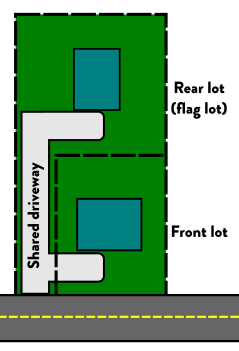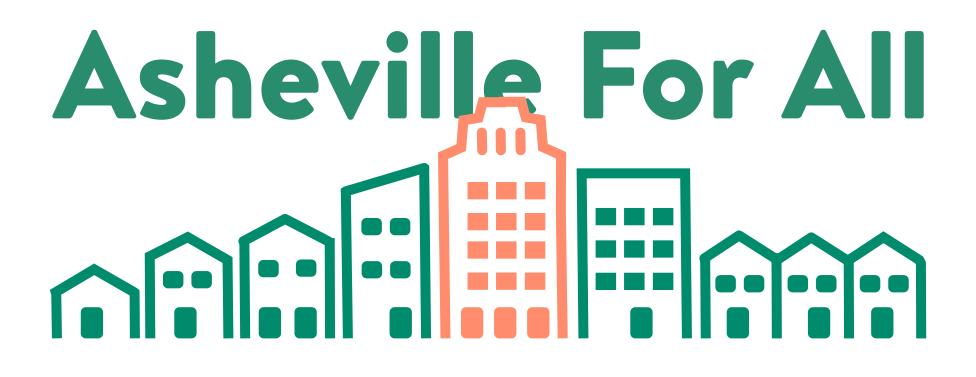Are Flag Lots the Answer to the ADU Problem?
October 19, 2023
This member commentary post does not necessarily reflect the views of Asheville For All or its members.
NOTE: The city council public hearing mentioned below has been rescheduled for January 23, 2024.
On Tuesday, Asheville City Council will be voting on an amendment to the city’s rules around flag lots. In short, flag lots allow two homes to be situated along the same street frontage, with one home in back of the other. This works because the lot for the home in back effectively has a narrow portion that sticks out to the street, presumably where a shared driveway is. It’s called a “flag lot” because that driveway portion looks like a flag pole.
Flag lots are already allowed in our city, but there are some restrictions around them. This new amendment mostly seeks to allow for “poles” that are narrower. That means flag lots will be more possible on many of the deep, narrow lots that we have in high-demand, high-amenity neighborhoods like West Asheville.
One way to think about making flag lots more permissible is that it’s another means to get to the same end as encouraging detached ADU’s.
Accessory dwelling units (ADUs), sometimes called “granny flats,” are allowed throughout Asheville, and the city sees them as an important part of its broader strategy of encouraging infill in our residential neighborhoods. (We should note that there are some odd restrictions around ADUs and how big they can get. Asheville For All discussed those restrictions a few months ago when we endorsed the statewide ADU bill that now seems unlikely to pass this year.)
One problem with ADUs is that if you want to build one in your backyard, it means that a) either you actually have a “granny” that is going to live there, or b) you intend to become a landlord. This doesn’t necessarily mean that ADUs can’t contribute to the housing shortage—The Washington Post had an article earlier this year showing some ADU success in California. But it does limit their appeal.
Further, ADU construction isn’t always easy to finance. If you already own a home, building an additional home in the back of it isn’t nearly as straightforward as getting a mortgage.
Enter Flag Lots?
A flag lot with a house on it doesn’t look so different from a detached ADU. The major difference is that the house in back exists on its own plot of land. There’s a technical term for this: the lot is said to be “fee simple.”

“Fee simple” means that you can live in a place without having to rent it, and without having to enter into a condo or homeowners association. These kinds of associations aren’t necessarily bad; and they make a lot of sense if you’re living in a triplex or larger building made up of townhomes or flats that are individually owned. But if you’re going to have a detached home on the market, being able to offer it up as fee simple makes things easier for the developer, the buyer, and/or the seller.
The Atlanta architecture and planning firm Kronberg Urbanists Architects (KUA) makes this case in a blog post on their website. Some Ashevilleans might remember KUA from Eric Kronberg’s visit earlier this year; he delivered a great presentation on the housing shortage and the role of “missing middle” development as a solution as part of Asheville Downtown Association’s speaker series. (Asheville For All shared some of the slides from that event.)
As the blog post suggests, “narrow pole flag lots” provide greater options to homeowners that want to subdivide their lot. They can “access more conventional loan products” than they could for ADU construction. And the homeowner in front can still own the back lot and rent out the new home. Or “they can sell the rear lot outright, instantly providing access to equity.” This a way for older homeowners in Asheville, for example, to downsize a little, reduce their tax burden, and help out others struggling due to the housing shortage and welcome new neighbors in the process.
Are there drawbacks to legalizing narrow-pole flag lots? First, it’s important to note that as we noted in the case of the ADU bill, there are still a ton of rules that will limit what can be built where. Not every lot in Asheville is suddenly going to be able to be subdivided for the construction of another home. All the usual rules that restrict the size and quantity of homes in our neighborhoods will still apply.
As KUA notes, in a block of ten homes, you are likely to only see one additional ADU or flag lot home at most. That should assuage NIMBYs worried about sudden traffic jams on their side streets. On the other hand, a ten percent increase in housing supply is still significant.
(Also, remember that flag lots are already legal in Asheville, unlike some other cities. The proposed amendment will simply lower the bar a little bit.)
But what about concerns that flag lots and ADUs are not enough?
When the flag lot amendment first went before the Planning and Zoning Commission in the summer, some people expressed concerns that this was a kind of distraction from—or possibly even a wrench in the gears of—the “missing middle” initiative.
I think those concerns are worth taking seriously. After all, if Asheville For All has one campaign that it sees as a priority right now, it’s missing middle. (You can read all about it here if you’re not up to speed.)
Looking Ahead to Missing Middle
Of course, if there’s one thing that we know about the housing shortage—both nationally and locally—it’s that we need to walk and chew gum at the same time if we’re going to tackle this thing. Density, more diverse housing options, and more widespread affordability for a variety of working people and their families will only come with an array of tools in our toolset. Ultimately, I don’t believe that there’s any conflict between a narrow-pole flag lot amendment that can be passed through fairly quickly, and a comprehensive and ambitious missing middle zoning reform that is likely to take a year or even two to see through to the finish line.
We’re still waiting for Asheville’s missing middle study to be delivered. After that, it’s likely to be another six months before the study is converted into a zoning code rewrite that the council will vote on. (The homeowners that typically oppose anti-exclusionary zoning reforms may at that point use tactics that make the process take even longer.)
There is a provision in the existing flag lot rule that could certainly be revised as part of the missing middle reform. Our zoning code’s section on flag lots begins with this line:
A flag lot shall serve only single-family residential development and accessory buildings.
So I suppose the concern from some people was that by encouraging narrow pole flag lots, we’d have a spate of new single family homes built when we should be aiming for multi-family.
But there’s no reason why the modest flag lot reform can’t pass now and we can’t revisit the above restriction next year. Striking that line would simply mean that any flag lot would be governed by the neighborhood’s intended restrictions on building purpose, size, or density. Just like any other lot.
And there’s no reason why a flag lot, just like a regular lot, couldn’t have its maximums scale up, alongside its number of units, as Opticos appears to recommend, in order to discourage large single-family homes but encourage duplexes, triplexes, quadplexes, etc. (One concern expressed last summer was that homes on rear flag lots are allowed to be bigger, and thus possibly less attainable for renters, than ADUs.)
(Of course, the largest lots in Asheville can already be converted into flag lots. We are highly unlikely to see any 3,000 square feet homes on the small lots to which a narrow-pole flag lot amendment will apply!)
Also with a rear setback and front setback between front and back lots respectively, there’s no reason to believe that a developer with a blank slate would opt for flag lots, once missing middle reforms and incentives are finally in place. Especially when our region has such a “mismatch” between the kinds of homes that are being built and the lower cost homes that are in demand. Just as with ADUs—which are understood to be a part of the missing middle housing toolset for adding density to residential neighborhoods—flag lots are much more of a tool for homeowners who, in a world where missing middle is legal, might still want to stay where they are rather than cash out.
We should remain laser-focused on increasing the variety of housing types in the city, and in scaling up our density beyond detached single family homes, and I’m grateful to the city’s planning department for remaining so focused. Still, infill density is infill density, and the more options we can provide to local builders and homeowners, especially as we wait for the bigger changes to be implemented, the more and more immediate relief we can bring to working families in what is a particularly brutal market right now.
This member commentary post does not necessarily reflect the views of Asheville For All or its members.
